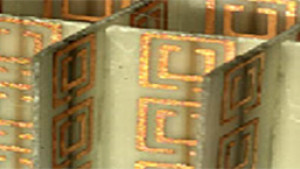In metals, light can couple to electrons to form a wave that is bound to the surface of the metal. This wave is called the surface plasmon. The surface plasmon mode is generally characterized by intense fields that decay exponentially away from the interface between the metal and the surrounding environment. Surface plasmons display very important properties, including strongly enhanced local fields; tremendous sensitivity to changes in the local environment; and the ability to localize energy to tiny volumes not restricted by the wavelength of the exciting light.
Due to their unique properties, plasmons have found a broad range of applications in various areas of science. In chemistry and biology for example, the sensitivity of surface plasmons is used to form the basis for powerful chemical and biochemical detectors that can monitor molecular binding events. In optics, the large field strengths of surface plasmons can dramatically enhance a variety of phenomena such as Raman scattering and light transmission through sub-wavelength apertures. In addition, the size of certain SPP configurations can be smaller than the operation wavelength, thus offering a path to decrease the size of optical components beyond the diffraction limit.
In this context, SPPs have an enormous potential in integrated photonics, as their sensitivity raises considerable hope for enhancing the performance of modulators, switches and chip-scale optical sensors. The engineering of integrated plasmonic circuits follows a much more focused path than the more fundamental studies of surface plasmons and nanoparticles. An integrated circuit contains, on a single compact substrate, a variety of functional components (filters, couplers, modulators) that are connected with integrated waveguides. One must be able to precisely calculate how the energy is distributed among the elements of the circuit, how to calculate the transitions between different elements of the circuit and how to minimize all the losses. Another specific concern is the reproducibility, as one should be able to fabricate circuits that not only agree with the simulations but also that systematically give the same results no matter the sample.
Although the issues described above are critical for any integrated photonic architecture, they are of particular importance for plasmonic circuits. In general, the large absorption inherent to metals makes them unattractive for practical, competitive devices. The challenge in plasmon engineering, then, lies in mitigating the losses of plasmonic circuits while leveraging their unique properties. In addition, the sensitivity of the plasmon modes renders their precise modeling more difficult as compared with conventional optics. Due to these difficulties, it is important to identify a system model which is simple enough to simulate, fabricate and characterize, yet versatile enough to serve as the basis of more and more complex circuits.
At CMIP, work is underway on the use of thin metal stripes as integrated plasmonic waveguides and devices. These structures are excellent model systems because their properties can be accurately designed and leveraged by adapting numerical methods and experimental protocols used in dielectric waveguide engineering. The thin metal stripe geometry supports a very special type of surface plasmon, called the long-range surface plasmon (LRSP). The LRSP is characterized by electromagnetic fields that are mostly contained in the region outside of the metal, so that the light exhibits a lateral confinement on the order of several wavelengths. Because of these characteristics, LRSPs can propagate the farthest of all known metallic modes (centimeter distances at infrared wavelengths and millimeters at visible wavelengths). Yet, like all plasmon modes, LRSPs remain extremely sensitive to their surrounding environment and are thus of interest for sensing purposes and active photonic applications.
A current goal of CMIP is to build a comprehensive toolbox for LRSP engineering. At this stage, the toolbox comprises a fairly complete suite of numerical tools, fabrication procedures, and systematic experimental protocols for engineering LRSP devices.

